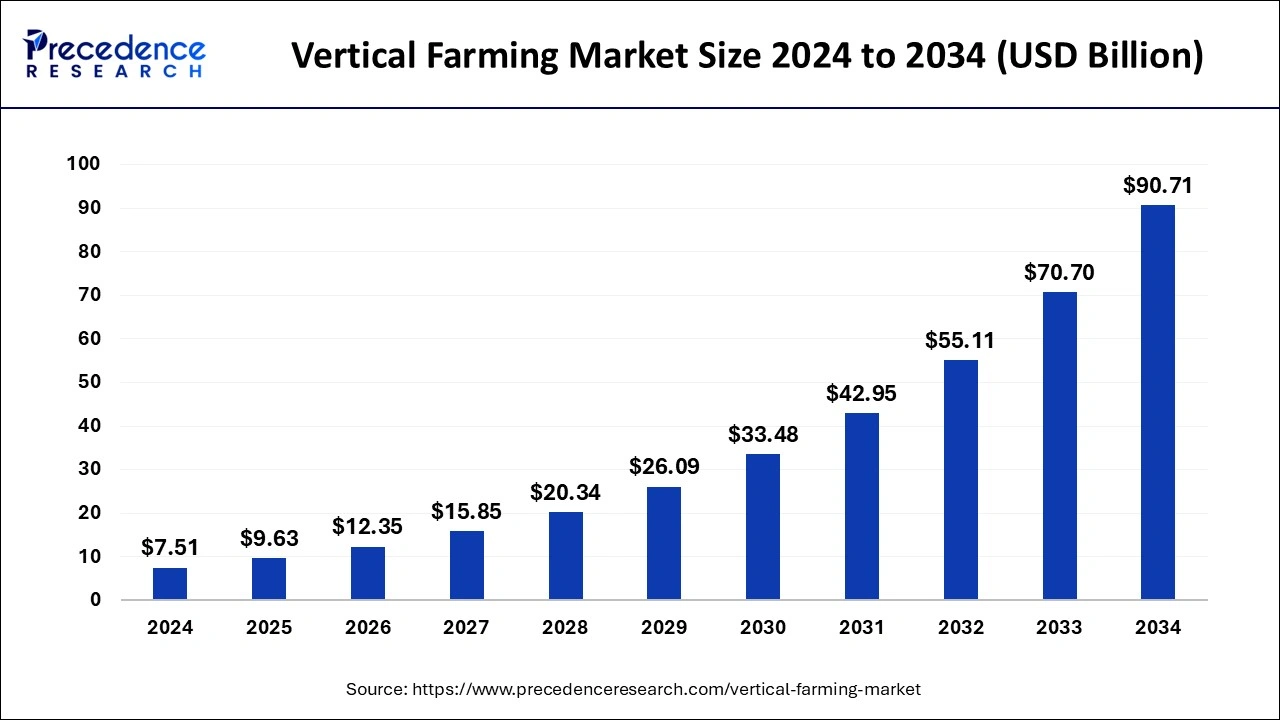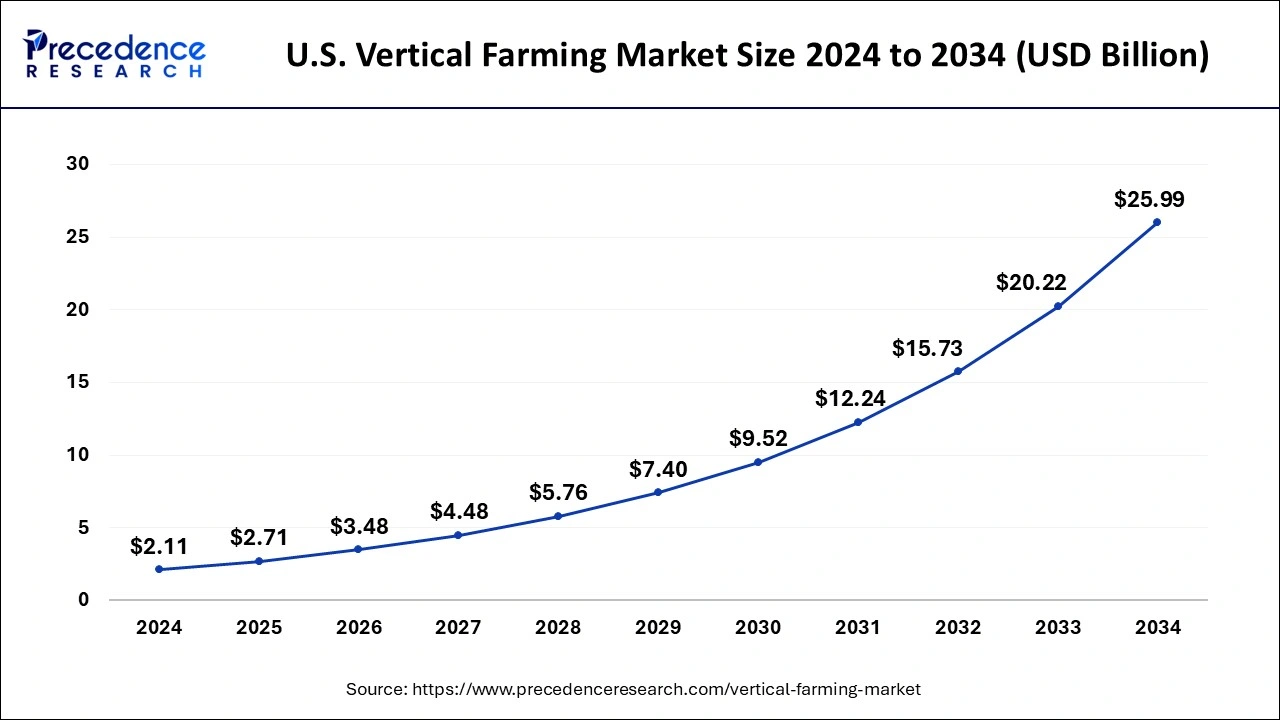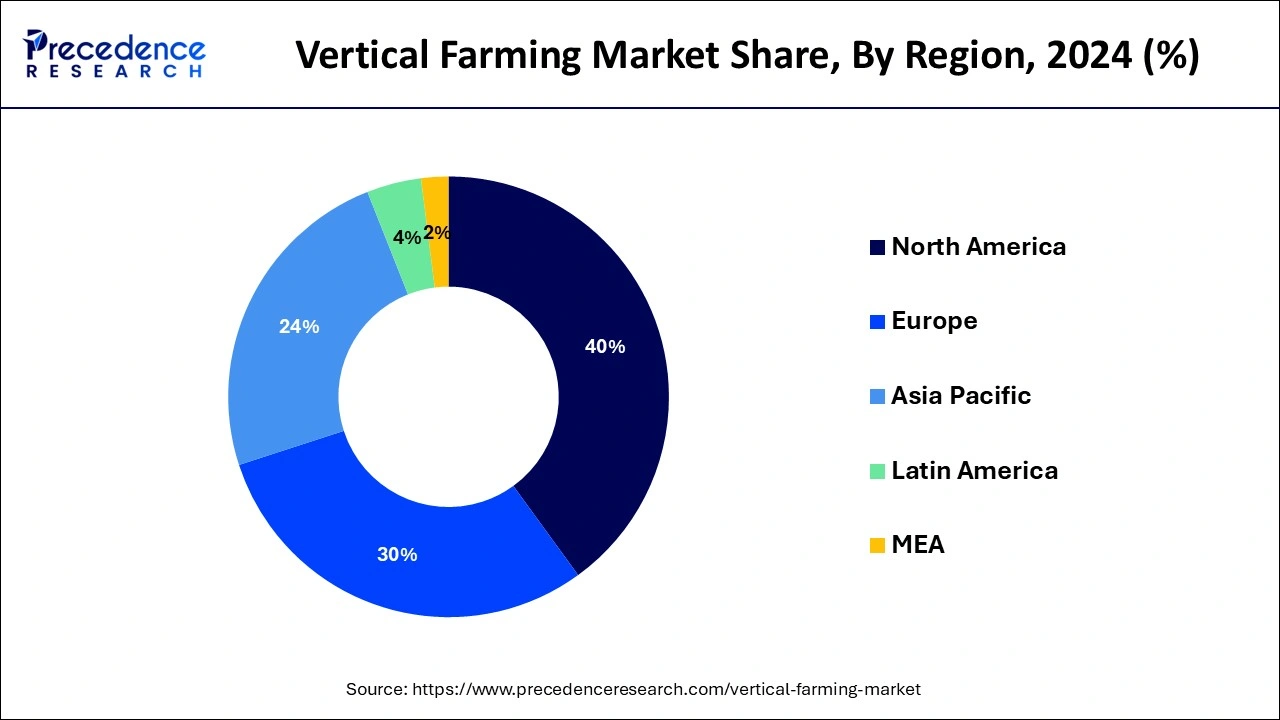What is the Vertical Farming Market Size?
The global vertical farming market size is accounted at USD 9.63 billion in 2025 and predicted to increase from USD 12.35 billion in 2026 to approximately USD 90.71 billion by 2034, representing a CAGR of 8.3% from 2025 to 2034.

Vertical Farming Market Key Takeaways
- North America led the global market with the highest market share of 40% in 2024.
- By structure, the shipping container segment has captured a revenue share of around 54.3% in 2024.
- The building-based segment held a revenue share of 45.7% in 2024.
- By growth mechanism, the hydroponics segment has held a 41% revenue share in 2024.
Market Overview
Vertical farming by 2050 is considered to be a new method for feeding huge global populations. Building a farm that is close to the people it serves by supplying cheaper, organic, disease-free crops and preserving limited natural resources. The more sustainable and innovative method of agriculture than conventional agriculture and greenhouse farming is known to be vertical farming. It takes very little water and saves a large amount of soil and space. In difficult conditions, such as villages, mountain towns and deserts, this farming method is useful. The growth of the global vertical farming market is driven by rising customer health awareness, along with increasing urbanization and increasing per capita income. Indoor farming methods are also used by companies involved in the manufacture of pharmaceutical goods for cultivation and crop production in a green climate. Many pharmaceutical companies are introducing indoor farming techniques that are commonly used in producing biopharmaceutical products for the production of various crops.
Vertical Farming MarketGrowth Factors
- Rising population levels across the globe
- Stabilized crop production irrespective of climatic changes
- Insufficiency of farming land worldwide
- Conservation as well as reutilization of natural resources
Market Outlook
- Industry Growth Overview - The market is witnessing strong growth driven by urbanization, increasing demand for fresh and sustainable produce, and technological advancements in indoor farming. Rising investment in automation, AI, and energy-efficient systems is further accelerating market expansion.
- Global Expansion - The global market is expanding rapidly, fueled by urban population growth, limited arable land, and increasing demand for locally grown, sustainable produce. Adoption of advanced indoor farming technologies is driving growth across North America, Europe, and the Asia-Pacific.
- Startup Ecosystem -The startup ecosystem is thriving, with companies developing innovative solutions in AI-driven automation, hydroponics, and modular indoor farming. Strong investor interest, government support, and rising demand for sustainable urban agriculture are driving rapid growth and commercialization.
Market Scope
| Report Highlights | Details |
| Market Size by 2034 | USD 90.71 Billion |
| Market Size in 2026 | USD 12.35 billion |
| Market Size in 2025 | USD 9.63 billion |
| Growth Rate from 2025 to 2034 | CAGR of 28.3% |
| Largest Market | North America |
| Base Year | 2024 |
| Forecast Period | 2025 to 2034 |
| Segments Covered | Growth Mechanism, Component, Fruits, Vegetables & Herbs, Structure and Region |
| Regional Scope | North America, Europe, Asia Pacific, Latin America, Middle East & Africa (MEA) |
Growth Mechanism Insights
The prime market share in the global vertical farming market was recorded in 2024 by hydroponic segment. Over the projected period, the climate control segment is predictable to register a high CAGR. To drive demand for hydroponic components, increasing adoption of hydroponic components by farmers to minimize the weight load and infrastructure needed to support the equipment is anticipated. Vertical farming automation aims to minimize time to market, reduce costs for distribution, production and the environment, and standardize high quality.
Fruits, Vegetables & Herbs Insights
Using this method, strawberries, lettuce, leafy greens, and tomatoes are among the most cultivated vegetables. Of all products, due to its adaptability to grow in small spaces with limited need for additional care, lettuce shows significant growth. Validating the economic viability of that crop, which ensures that the company is making a large amount of money from its cultivation, is one of the important factors behind growing any crop in vertical farming. Similarly, one of the criteria is the time taken for crops to grow completely because some vegetables such as lettuce and mint grow quickly, while herbs and some fruiting crops take longer to grow, but can have higher margins than many other plants.
Structure Insights
In terms of revenue, the shipping container conquered the sector in 2024 and is projected to remain leading during the forecast era. This growth is accredited to the structure's capability to assistance grow crops irrespective of the geographical site. Over the forecast period, factors such as budding technological advances and penetration of precision farming are expected to drive the shipping container segment. In Japan, China, and other Asian countries, the building based segment is extensively accepted and is the fastest-growing segment by revenue due to its growing acceptance in the region.
U.S. Vertical Farming Market Size and Growth 2025 to 2034
The U.S. vertical farming market size was estimated at USD 9.63 billion in 2025 and is predicted to be worth around USD 28.50 billion by 2034, at a CAGR of 28.5% from 2025 to 2034.

North America held the largest share of the vertical farming market while contributing almost 40% of the market share in 2024. Vertical farming is gaining traction in North American countries with the rising efforts of sustainability and food security in the area. Vertical farming ensures food security by offering the solutions for producing food on building and even closer where they are planned to be consumed. The overall material shortage and supply chain disruptions during the COVID-19 pandemic offered a significant potential for the vertical farming market to grow in North America. The United States and Canada are observed to remain as the largest contributors to the market in the upcoming years. Growing urbanization and degradation of food product quality is observed to promote the market's expansion in the upcoming years.

Asia Pacific is anticipated to witness significant growth in the forecast period, due to various factors impacting, such as rapid urbanization, government support for new agriculture practices, and growing investment in agriculture technologies y countries like China, Japan, and India. The stringent environmental regulations encourage developing countries to embrace vertical farming to tackle food security issues. Asia has witnessed major demand for sustainable agriculture methods. The government initiatives and investment in organic and pesticide-free agriculture are contributing to the market growth. China is a major country leading the Asian market due to its vast agricultural practices of the country.
- In February 2025, the Chinese government launched the "Number One Document," an annual document on agriculture, that highlights food security and rural reform, emphasizing the importance of technological innovation in agriculture, including vertical farming.
Europe's Vertical Farming Revolution: Driving Sustainable and Efficient Agriculture
The European market is growing due to increasing urbanization, rising demand for fresh and locally grown produce, and a focus on sustainable agriculture. Supportive government policies, technological advancements in indoor farming systems, and growing consumer awareness of healthy eating are driving adoption. Additionally, the need to optimize limited arable land and reduce food supply chain dependencies further accelerates market growth across the region.
Transforming Agriculture: The UK's Innovation
The UK vertical farming market is growing due to increasing urban populations, limited arable land, and rising consumer demand for fresh, locally produced, and sustainable food. Government initiatives supporting innovative agricultural technologies, along with advancements in indoor farming systems, automation, and energy-efficient solutions, are driving adoption. Additionally, the focus on reducing food supply chain dependency and enhancing year-round crop production is further accelerating market growth in the UK.
Value Chain Analysis
- Harvesting and Post-Harvest Handling: Harvesting involves manual/mechanical gathering at peak maturity, followed by immediate sorting and cleaning to prevent damage and contamination. Leading vertical farming companies like Plenty and Bowery Farming use automation and AI in this stage to reduce handling losses, ensuring produce quality and shelf life.
- Storage and Cold Chain Logistics: Post-harvest, produce requires immediate pre-cooling and temperature-controlled storage to slow deterioration. The cold chain uses packhouses, refrigerated transport, and distribution centers for seamless connectivity to markets. Specialized logistics firms such as Snowman Logistics and Coldrush Logistics provide crucial temperature-controlled solutions for perishable goods.
- Export and Trade Compliance: Exporting requires adherence to strict international regulations, including obtaining an Import Export Code (IEC) from the DGFT and complying with destination-specific standards and customs procedures. Companies must ensure proper documentation (invoice, packing list, certificate of origin) and may work with experts or bodies like the Export Inspection Council of India (EIC) for certification and smooth customs clearance.
Key Players in Vertical Farming Market & Their Offerings:
- 4D Bios Inc- Provides modular vertical farming systems, intelligent plant factory solutions, and digitally controlled indoor growing infrastructure for large-scale and containerised crop production.
- Agrilution GmbH- Offers home scale automated vertical farming appliances and related ecosystem enabling users to grow herbs, micro greens, and leafy crops in indoor environments with app-based control.
- AeroFarms LLC- Develops high-tech indoor vertical farming platforms using advanced environmental control, automation, and aeroponics to deliver year-round crop production with high yield and quality.
- Hort Americas LLC- Supplies controlled environment agriculture equipment, nutrient delivery systems, and technology solutions tailored for indoor, greenhouse, and vertical farming operations.
- Illumina Inc.- Provides genomic sequencing platforms, microarrays, and agrigenomics solutions aimed at plant and animal breeding, trait screening, and sustainable agriculture research.
Vertical Farming Market Companies
- Urban Crop Solutions
- Koninklijke Philips N.V.
- AMHYDRO (American Hydroponics)
- Everlight Electronics Co., Ltd
- Others
Recent Developments
- On May 4, 2025, the study of the cultivation of six food groups in vertical farming, investigated by a research team led by TUMCREATE in Singapore, a research platform affiliated with the Technical University of Munich (TUM), as part of the Proteins4Singapore project, has been reported. The six food groups in vertical farming include crops, algae, mushrooms, insects, fish, and cultivated meat.
- On May 1, 2025, the Vertical Farm at Illinois State University officially opened to train and prepare students for careers in agriculture and horticulture specialty crop production, and as a demonstration site for local community groups, schools, and business entrepreneurs. The $200,000 project is a joint partnership of The College of Applied Science and Technology, Department of Agriculture, and Office of Sustainability, located adjacent to the Office of Sustainability at 305 North School Street, Normal, Illinois.
- In January 2025, GoodLeaf Farms secured funding from Farm Credit Canada (FCC) to help the company expand its vertical farming operations across Canada.
Major Market Segments Covered
By Growth Mechanism
- Hydroponics
- Aeroponics
- Aquaponics
By Component
- Lighting
- Climate Control
- Sensor
- Irrigation
- Others
By Fruits, Vegetables & Herbs
- Bell & Chili peppers
- Strawberry
- Tomato
- Lettuce
- Cucumber
- Herbs
- Leafy Greens (excluding lettuce)
- Others
By Structure
- Shipping Container
- Building-based
By Geography
- North America
- U.S.
- Canada
- Europe
- Germany
- France
- United Kingdom
- Rest of Europe
- Asia Pacific
- China
- Japan
- India
- Southeast Asia
- Rest of Asia Pacific
- Latin America
- Brazil
- Rest of Latin America
- Middle East & Africa (MEA)
- GCC
- North Africa
- South Africa
- Rest of Middle East & Africa
For inquiries regarding discounts, bulk purchases, or customization requests, please contact us at sales@precedenceresearch.com
Frequently Asked Questions
Ask For Sample
No cookie-cutter, only authentic analysis – take the 1st step to become a Precedence Research client
 sales@precedenceresearch.com
sales@precedenceresearch.com
 +1 804-441-9344
+1 804-441-9344